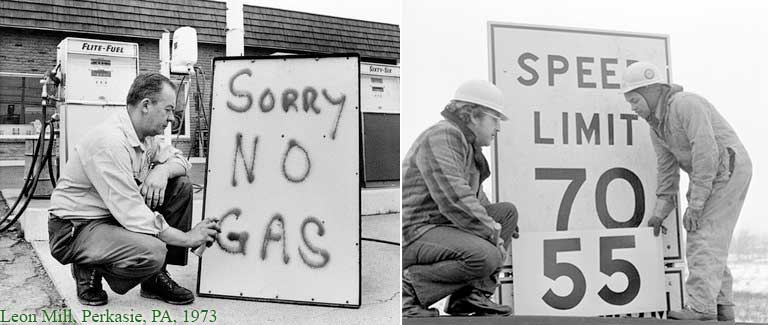Air resistance and energy
Cars traveling on highways, even bicycles at cruising speed, are at high enough Reynolds number that the main source of air resistance is the quadratic term (accelerating that tube of air we pass through!).
Arab oil crisis
Arab countries were incensed by U.S. military support for Israel in its 1973 war against Syria and Egypt. As punishment, Arab oil producing countries stopped shipping oil to the U.S.
- The 1973 Oil Embargo (NPR).

- How the 1973 Oil Embargo Saved the Planet (Foreign Affairs). "It gave us a headstart on dealing with climate change."
How much gas can be saved by reducing speeds on highways from 70 mph to 55 mph?* (55 is ~80% of 70.)
[* Based on how people pay attention to speed limits, maybe this was effectively moving from 75$\to$60 mph.]
- Consider the energy ($W=F\cdot d$) required to overcome quadratic air resistance during a trip of $d$ miles at a constant speed, $v$. This energy varies with what power of $v$?
- At 55 mph, what percentage are you using of the energy you used for the same distance at 70 mph?
(55/70)^2=0.62
- How does the power your car requires to overcome quadratic air resistance scale with speed?
Goshen College electricity usage

Gross square feet vs time;
Electric consumption (12-mo moving average) vs time;
 Smart people in our PhysPlant realized they could retrofit our HVAC ("Heating, Ventilation, Air Conditioning") systems with VFDs ("Variable Frequency Drives") on air handling equipment and program thermostats remotely. Consider this winter scenario:
Smart people in our PhysPlant realized they could retrofit our HVAC ("Heating, Ventilation, Air Conditioning") systems with VFDs ("Variable Frequency Drives") on air handling equipment and program thermostats remotely. Consider this winter scenario:
- A thermostat "calls for heat" when the temperature in a room drops below a set point. A fan starts blowing heated air.
- The fan is either "off" or "on".
- In the morning, if someone comes into a cold room, they want it to heat up quickly. So, "on" is usually set at the factory to a relatively high speed.
- But just like cars pushing air out of the way, the energy cost of moving a fixed amount of air increases as $v^2$.
- VFDs allow a computer system to run a fan motor at any speed you like.
- Most rooms at GC are now programmed to slowly heat up (slow fan speeds) in the morning before they are schedule to be occupied.
- Once up to temperature "fast" heat response is usually not needed.
- Fans can run slow and still move the same amount of hot air!
Thanks Glenn! Thanks Steve! Thanks Clay!